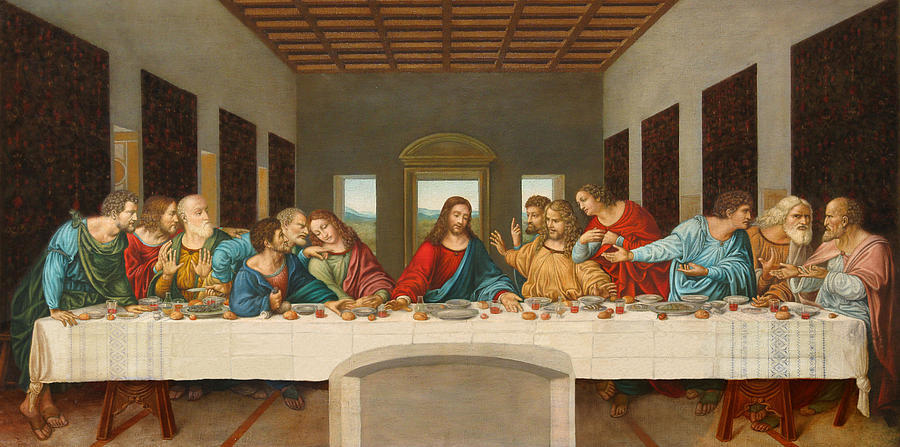Spiritual Sunday
Today’s Gospel lesson deals with Christianity’s key metaphor, which is also a cause of dispute between Protestants and Catholics. When we participate in the Eucharistic feast, Catholics contend we are literally consuming the body and blood of Christ (transubstantiation) where Protestants contend it’s a metaphor. Today’s poem acknowledges the metaphor but opts for the literal.
The reading from John, somewhat comically, has Jesus’s audience thinking literally:
Jesus said, “I am the living bread that came down from heaven. Whoever eats of this bread will live forever; and the bread that I will give for the life of the world is my flesh.”
The Jews then disputed among themselves, saying, “How can this man give us his flesh to eat?” So Jesus said to them, “Very truly, I tell you, unless you eat the flesh of the Son of Man and drink his blood, you have no life in you. Those who eat my flesh and drink my blood have eternal life, and I will raise them up on the last day; for my flesh is true food and my blood is true drink. Those who eat my flesh and drink my blood abide in me, and I in them. Just as the living Father sent me, and I live because of the Father, so whoever eats me will live because of me. This is the bread that came down from heaven, not like that which your ancestors ate, and they died. But the one who eats this bread will live forever.”
The symbolism, of course, surfaces again in the Last Supper:
And he took bread, and gave thanks, and brake it, and gave unto them, saying, This is my body which is given for you: this do in remembrance of me. Likewise also the cup after supper, saying, This cup is the new testament in my blood, which is shed for you. (Luke 22:19-20)
I’m assuming from “Transubstantiation” that poet Chard DeNiord is Catholic because he insists on the literal. To be sure, he also sees it as a metaphor, but not metaphorical in the way that, say, the rose of Sharon in Song of Solomon gets read as a metaphor for Christ. When we consume the Eucharistic bread, DeNiord says, it lives in us in a different kind of way and our hearts are seized by what is possible. When the Holy Spirit (the Paraclete) becomes “a meal,” it enters our body like an idea—we fuse “him with us in prayer”—but it’s not just an idea (a metaphor) since we are eating literal bread (“the host was form”).
If it sounds elusive, well, that’s because DeNiord is using words to capture something that goes beyond words, the miraculous moment where something material becomes divine. So in another articulation, DeNiord says that, when we are ready to receive the Eucharist, we know “the presence of his body as real.” We enter the ceremony “for the sake of becoming him” and for a moment we become him. He is “changed for a while.”
It may make us “feel foolish afterwards“ as “there was nothing I could say to prove it.” Jesus, who conjures up images of bleeding bread with his metaphor, seems vain in proposing, while under “duress,” that mutable flesh will transform into some eternal. And yet the taste makes us “feel and see anew and think again.”
I read the hazelnut, by the way, as a reference to Julian of Norwich, who meditated upon a hazelnut and had a vision of God’s immense love for even the smallest and most obscure of things. As she is having her revelation (or showing), the insight feels more visceral than a cerebral metaphor. Or as DeNiord describes the moment of ingesting the Eucharist,
when we said we take this bread our hearts were seized
by what was possible which was all things…
Transubstantiation
By Chard DeNiord
I said yes immediately when you asked if I believed
in it and I didn’t feel that foolish for saying so
although I did feel foolish afterwards in thinking
about it for there was nothing I could say to prove it
I only knew that it was true in another way that made
religious sense in linking back to a metaphor that kept
its word that loved the body as well as mind and took
another form by which we came to call something else
the blood and body of Christ fully conscious then
of the difference between the substitute and flesh itself
which was so mutable in his duress that vanity proposed
to death and fruit transformed from words to flesh
or else His voice lacked the strength to bear a hazelnut
from nothingness the taste of it quite moot as long
as we believe lives in us in such a way that we could say
with confidence that this was that and that was this because
he said it was and what he said was not a metaphor in the way
we think in curious ways that made us feel and see anew
and think again but not believe in bleeding bread
I mean my love was the rose of Sharon but only because
she inspired this while staying herself and knowing
the difference hearts were prone to such fallaciousness
yet when we said we take this bread our hearts were seized
by what was possible which was all things but not everything
you see which was absurd and mystical which was
the Paraclete becoming a meal and entering our bodies
like an idea but not an idea since the host was form
already and fusing him with us in prayer but not only then
when we were ready and knew the presence of his body as real
if changed for a while for the sake of becoming him


